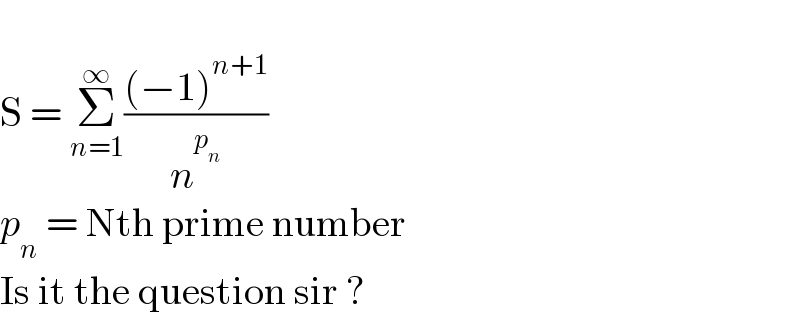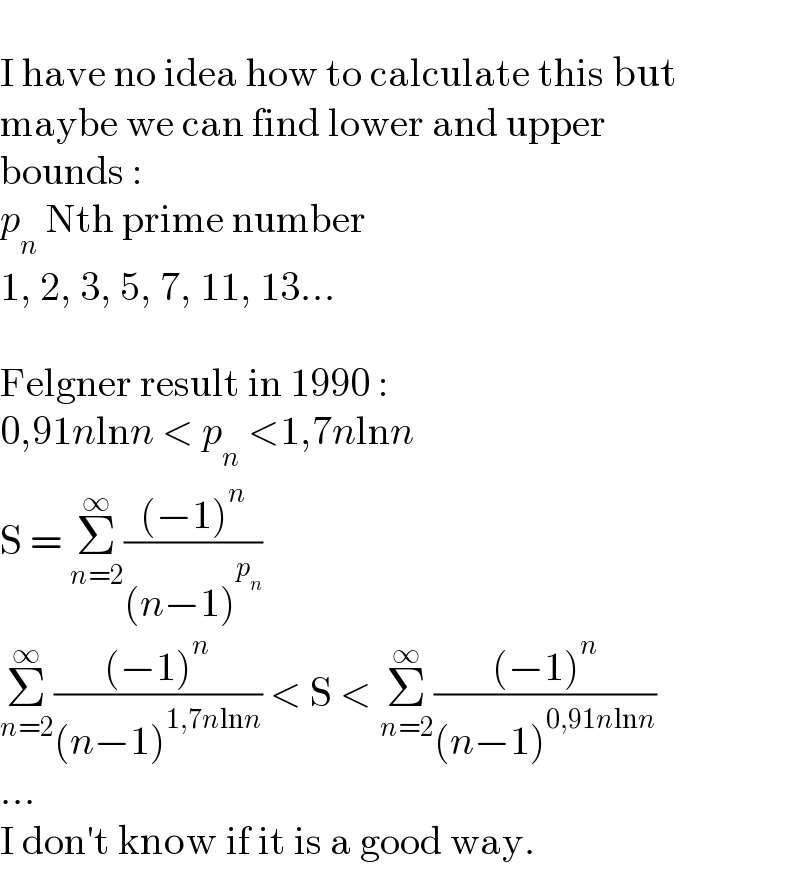Question Number 126200 by Dwaipayan Shikari last updated on 18/Dec/20

$$\frac{\mathrm{1}}{\mathrm{1}^{\mathrm{2}} }−\frac{\mathrm{1}}{\mathrm{2}^{\mathrm{3}} }+\frac{\mathrm{1}}{\mathrm{3}^{\mathrm{5}} }−\frac{\mathrm{1}}{\mathrm{4}^{\mathrm{7}} }+\frac{\mathrm{1}}{\mathrm{5}^{\mathrm{11}} }−\frac{\mathrm{1}}{\mathrm{6}^{\mathrm{13}} }+…. \\ $$
Commented by Olaf last updated on 18/Dec/20

$$ \\ $$$$\mathrm{S}\:=\:\underset{{n}=\mathrm{1}} {\overset{\infty} {\sum}}\frac{\left(−\mathrm{1}\right)^{{n}+\mathrm{1}} }{{n}^{{p}_{{n}} } } \\ $$$${p}_{{n}} \:=\:\mathrm{Nth}\:\mathrm{prime}\:\mathrm{number} \\ $$$$\mathrm{Is}\:\mathrm{it}\:\mathrm{the}\:\mathrm{question}\:\mathrm{sir}\:? \\ $$
Commented by Dwaipayan Shikari last updated on 18/Dec/20

$${yes}\:{sir}! \\ $$
Commented by Olaf last updated on 18/Dec/20

$$ \\ $$$$\mathrm{I}\:\mathrm{have}\:\mathrm{no}\:\mathrm{idea}\:\mathrm{how}\:\mathrm{to}\:\mathrm{calculate}\:\mathrm{this}\:\mathrm{but} \\ $$$$\mathrm{maybe}\:\mathrm{we}\:\mathrm{can}\:\mathrm{find}\:\mathrm{lower}\:\mathrm{and}\:\mathrm{upper} \\ $$$$\mathrm{bounds}\:: \\ $$$${p}_{{n}} \:\mathrm{Nth}\:\mathrm{prime}\:\mathrm{number} \\ $$$$\mathrm{1},\:\mathrm{2},\:\mathrm{3},\:\mathrm{5},\:\mathrm{7},\:\mathrm{11},\:\mathrm{13}… \\ $$$$ \\ $$$$\mathrm{Felgner}\:\mathrm{result}\:\mathrm{in}\:\mathrm{1990}\:: \\ $$$$\mathrm{0},\mathrm{91}{n}\mathrm{ln}{n}\:<\:{p}_{{n}} \:<\mathrm{1},\mathrm{7}{n}\mathrm{ln}{n} \\ $$$$\mathrm{S}\:=\:\underset{{n}=\mathrm{2}} {\overset{\infty} {\sum}}\frac{\left(−\mathrm{1}\right)^{{n}} }{\left({n}−\mathrm{1}\right)^{{p}_{{n}} } } \\ $$$$\underset{{n}=\mathrm{2}} {\overset{\infty} {\sum}}\frac{\left(−\mathrm{1}\right)^{{n}} }{\left({n}−\mathrm{1}\right)^{\mathrm{1},\mathrm{7}{n}\mathrm{ln}{n}} }\:<\:\mathrm{S}\:<\:\underset{{n}=\mathrm{2}} {\overset{\infty} {\sum}}\frac{\left(−\mathrm{1}\right)^{{n}} }{\left({n}−\mathrm{1}\right)^{\mathrm{0},\mathrm{91}{n}\mathrm{ln}{n}} } \\ $$$$… \\ $$$$\mathrm{I}\:\mathrm{don}'\mathrm{t}\:\mathrm{know}\:\mathrm{if}\:\mathrm{it}\:\mathrm{is}\:\mathrm{a}\:\mathrm{good}\:\mathrm{way}. \\ $$
